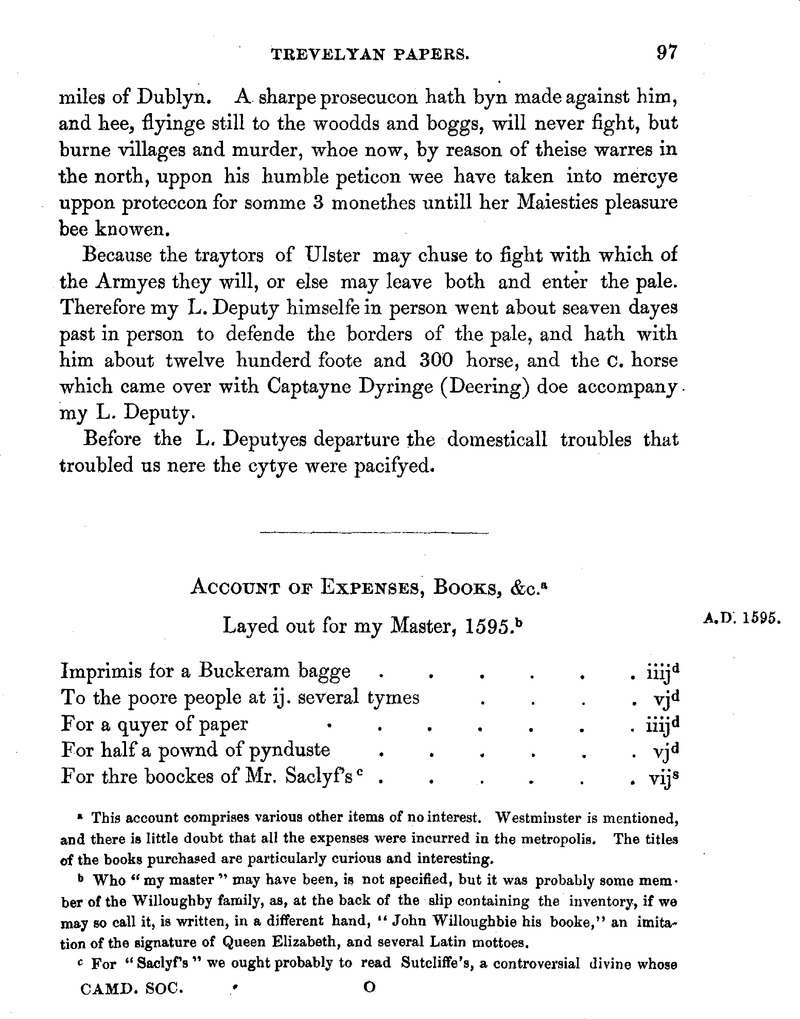No CrossRef data available.
Article contents
Abstract

- Type
- Sir William Cavendish's Book
- Information
- Copyright
- Copyright © Royal Historical Society 1863
References
page 97 note b Who “my master” may have been, is not specified, but it was probably some member of the Willoughby family, as, at the back of the slip containing the inventory, if we may so call it, is written, in a different hand, “John Willoughbie his booke,” an imitation of the signature of Queen Elizabeth, and several Latin mottoes.
page 97 note c For “Saclyf's” we ought probably to read Sutcliffe's, a controversial divine whose earliest work, we believe, appeared in 1591, viz. his “Treatise of Ecclesiastical Discipline.” Next year he published his “Answer to a certain Libel, &c.;” and, in 1595, the year when this account bears date, his “Answer to Job Throckmorton.” These might be th e very “three books “mentioned in the account.
page 98 note a “For peyrce Pennyles” can only refer to Thomas Nash's famous tract, “Pierce Penneless his Supplication to the Devil,” six times printed in 1593, and often afterwards, on account of its extreme popularity.
page 98 note a “Tarlton's Jests” must have been originally printed soon after the death of that most distinguished actor in 1584, but no edition of the book is known until many years afterwards, viz. in 1611. We may presume that all the earlier copies were destroyed by the thumbs and ringers of careless readers. It was also reprinted in 1630, but the book in any form and of any date is a great rarity. It was reprinted by the Shakespeare Society in 1844. c This item may refer either to the fee paid to Dr. Smyth for giving an opinion upon the contents of a urinal, or it may mean that 12d. were laid out for conveyance upon the Thames—probably the former.
page 98 note d This item must relate to the purchase of an early copy of the well known work, “Robin Goodfellow, his mad Prankes and merry Jests,” the first edition of which now known is dated 1628. That it was printed in 1590, or even earlier, can be abundantly proved, and here we see it mentioned in 1595 as having been bought in London. There was, however, a ballad in the form of a chap-book, then also in existence, under the title of “The merry Pranks of Kobin Good-fellow, very pleasant and witty.”
page 98 note e This is the most valuable entry in the whole of the account, since it proves incontesti-bly that the old “Historie of Hamblet,” upon which Shakespeare founded his tragedy, was in a printed shape in 1595. The only known copy of it bears the date of 1608, five or six years after the play by our great dramatist was brought out. The subject was then unquestionably not new upon the stage, for Nash speaks of a tragedy called “Hamlet” as early as 1587, and we know that in 1594, the year before the date of this account, a “Hamlet” (not Shakespeare's) was acted at Newington Butts theatre.




